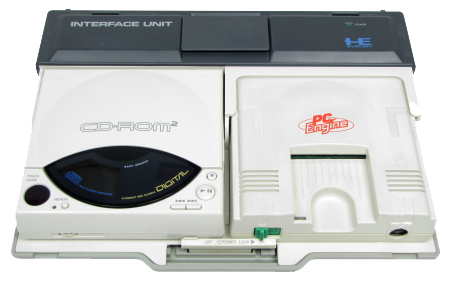PC Engine主機 + CDROM2
NEC的PC Engine是1987年推出的家用遊戲主機,該主機標誌著8位和16位遊戲機時代的交替。PC Engine的推出為日本市場注入新鮮活力,並與任天堂和世嘉等巨頭展開競爭。以其緊湊的設計、出色的2D圖形表現以及獨特的HuCard遊戲卡形式迅速獲得關注。為進一步增強主機的功能,NEC在1988年推出CD-ROM2系統,使PC Engine成為第一款支援CD-ROM遊戲的家用主機,為遊戲產業帶來革命性的變化。
PC Engine是由Hudson Soft和NEC共同開發。主機採用8位元的Hudson Soft HuC6280A CPU,主頻為1.79 MHz至7.16 MHz,具有16位元的圖形處理能力,使得PC Engine在當時能夠展示細膩的2D畫面。使用的是HuCard形式的遊戲卡帶,這種卡帶非常小巧,方便攜帶,並且具備較快的讀取速度。
為突破卡帶容量的限制,推出CD-ROM2系統,這是一個外接的CD光碟機,通過與PC Engine主機的接口單元(Interface Unit)連接,將主機的遊戲容量大大提升。系統採用的是當時較新的光碟技術,容量高達540MB,相較於HuCard的幾MB容量。這使得開發者可以創作更長、更複雜的遊戲內容,並且支援高質量的音樂和動畫過場。
規格方面,PC Engine主機內建64KB的內存,圖形處理能力支援512色同時顯示,並具備兩層圖形平面的顯示功能,能夠呈現豐富的遊戲畫面。與之搭配的CD-ROM2系統內置64KB的音效RAM,和64KB的數據緩存,用於處理CD-ROM中的音效和遊戲數據。這套系統能夠實現當時無與倫比的音質效果,尤其是在遊戲配樂和語音方面,提供優越的表現。
PC Engine及其CD-ROM2系統的優點主要體現在兩個方面。首先,PC Engine的硬體設計非常精巧,是當時市場上體積最小的家用遊戲機之一,外形簡潔而不失時尚。其次,CD-ROM2系統的加入,使得遊戲的內容得到極大的豐富。由於CD光碟的容量大幅度增加,開發者可以在遊戲中加入高質量的音樂、語音以及過場動畫,這大大提升遊戲的沉浸感和娛樂性。此外,PC Engine與CD-ROM2的組合為多媒體遊戲的發展開創先河,開啟家用遊戲機支援CD-ROM格式的時代。
然而,這套系統也存在一些缺點。首先,CD-ROM2系統的價格較高,在一定程度上限制其市場普及率。其次,由於光碟技術在當時還不夠成熟,CD-ROM2系統存在讀取速度較慢的問題,影響到遊戲的流暢性。再者,由於NEC的市場推廣不夠強勁,導致PC Engine在海外市場的表現不如在日本市場亮眼,尤其是在北美市場,未能與任天堂和世嘉的主機抗衡。
主要遊戲方面,PC Engine及其CD-ROM2系統擁有豐富且多樣化的遊戲陣容。其中,《夢幻模擬戰》(Langrisser)是經典的戰略角色扮演遊戲,憑藉其深刻的劇情和複雜的戰術系統,獲得廣泛的好評。《伊蘇》(Ys I & II)則以其精美的圖形和動人的音樂,成為RPG愛好者心中的經典。《PC原人》(Bonk’s Adventure)則以其獨特的橫向捲軸玩法和幽默的風格,成為PC Engine上的代表作之一。
在銷售方面,PC Engine在日本市場取得不錯的成績,總銷量超過600萬台。相比之下,其在北美市場的銷量則遠不及競爭對手,這主要是由於當地市場環境的競爭激烈和市場宣傳方面的不足。CD-ROM2系統作為一個附加設備,其銷售數據也相對有限,但仍然在日本市場上取得一定的成功。
總結來說,PC Engine與CD-ROM2系統的組合在遊戲主機歷史上佔有重要地位。儘管在全球市場上的表現不如預期,但它們為多媒體遊戲的發展和家用主機的技術進步做出重要貢獻。PC Engine成功地將CD-ROM技術引入家用遊戲領域,開創高容量遊戲和高質量音樂的時代。
NEC's PC Engine is a home gaming console that was released in 1987, marking the transition between the 8-bit and 16-bit gaming eras. The launch of the PC Engine brought fresh energy to the Japanese market and initiated competition with industry giants like Nintendo and Sega. The console quickly gained attention for its compact design, impressive 2D graphics performance, and the unique HuCard game card format. To further enhance its capabilities, NEC released the CD-ROM² system in 1988, making the PC Engine the first home console to support CD-ROM games, revolutionizing the gaming industry.
The PC Engine was co-developed by Hudson Soft and NEC. It featured an 8-bit Hudson Soft HuC6280A CPU with a clock speed ranging from 1.79 MHz to 7.16 MHz and 16-bit graphics processing capabilities, allowing the PC Engine to deliver highly detailed 2D graphics at the time. The console used HuCards, which were small, portable game cards that offered fast loading speeds.
To overcome the limitations of the HuCard's storage capacity, NEC introduced the CD-ROM² system, an external CD drive that connected to the PC Engine through an Interface Unit, significantly increasing the console's game storage capacity. This system used the then-new CD technology, offering up to 540MB of storage compared to the HuCard's few megabytes. This allowed developers to create longer and more complex games, as well as support higher-quality music and animated cutscenes.
In terms of specifications, the PC Engine featured 64KB of built-in memory and supported 512 simultaneous colors with dual-layer graphics planes, which allowed for visually rich gaming experiences. The accompanying CD-ROM² system included 64KB of sound RAM and 64KB of data cache to handle the audio and game data from the CD-ROM, providing exceptional audio quality, especially in terms of in-game music and voice acting.
The strengths of the PC Engine and its CD-ROM² system lay in two key areas. First, the hardware design of the PC Engine was extremely compact, making it one of the smallest home consoles on the market at the time, with a sleek and stylish appearance. Second, the addition of the CD-ROM² system greatly enriched the game content. The substantial increase in storage capacity enabled developers to include high-quality music, voice acting, and cutscenes, which greatly enhanced the immersion and entertainment value of games. Furthermore, the combination of the PC Engine and CD-ROM² system pioneered the development of multimedia games and ushered in the era of CD-ROM-supported home consoles.
However, there were some drawbacks to the system. Firstly, the CD-ROM² system was relatively expensive, limiting its widespread adoption in the market. Additionally, because CD technology was still in its early stages, the CD-ROM² system suffered from slower loading times, which impacted the smoothness of gameplay. Furthermore, NEC's marketing efforts were not as strong, resulting in the PC Engine's underperformance in overseas markets, particularly in North America, where it struggled to compete with consoles from Nintendo and Sega.
In terms of games, the PC Engine and its CD-ROM² system offered a rich and diverse lineup. Notable titles include Langrisser, a classic strategy RPG praised for its deep storyline and complex tactical system. Ys I & II became a fan favorite among RPG enthusiasts due to its stunning graphics and captivating music. Bonk’s Adventure, with its unique side-scrolling gameplay and humorous style, became one of the signature titles on the PC Engine.
In terms of sales, the PC Engine performed well in the Japanese market, selling over 6 million units. In contrast, its sales in North America lagged behind competitors, primarily due to the intense competition and NEC's weaker marketing efforts in that region. As for the CD-ROM² system, while its sales figures were relatively modest as an add-on accessory, it still achieved some success in the Japanese market.
In conclusion, the PC Engine and CD-ROM² system hold a significant place in gaming history. Although their global performance did not meet expectations, they made substantial contributions to the development of multimedia gaming and technological advancements in home consoles. The PC Engine successfully introduced CD-ROM technology to the home gaming world, paving the way for high-capacity games and high-quality audio experiences.
運費計算方式:
貨款滿1000元運費外加90元
貨款1000以下:買1件運費外加 60元,買2件運費外加 70元,
買3件運費外加 80元 ,買4件運費外加 90元
貨到付款外加30元手續費
外島及大陸地區運費另計
付款方式:
線上刷卡:本站採用Paypal線上刷卡
虛擬帳號匯款:屬於您專屬的虛擬帳戶,方便站長查帳使用,本站強力推薦
實體ATM匯款:請將匯款帳號記錄下來至各大銀行ATM提款機轉帳
超商條碼繳費:請列印本站提供的條碼至四大超商繳費
線上轉帳:透過玉山銀行線上ATM轉帳(此系統只支援IE瀏覽器)
貨到付款:本站採用黑貓宅急便貨到付款
其他注意事項:
如需購買線上點數卡請直接跟站長連絡,本站不提供點數卡的線上付款
-
PC Engine主機 + CDROM2
- 定 價: 0
- 售 價: 0.00
- 庫存量: 0 套
- 已賣出: 0 套
 人氣指數: 0.7 / 6 顆星
人氣指數: 0.7 / 6 顆星

